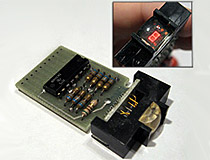Burrough's BIPCO product line is a series of intelligent driver sockets designed to compliment their extensive range of Nixie display tubes. BIPCO driver modules were produced with a wide range of functions, some merely provide high voltage level shifting of TTL logic signals, while more complicated models include BCD decoding, built in latches, or even integrated Nixie power supplies. The two examples shown here represent the most common form-factor used for these devices. Both the BIP-8232 and BIP-8521 are built around a standard 8422 Nixie tube socket. Attached to this is a green diallyl phthalate extension which contains the transistorized Nixie driver circuitry. The resulting device is very compact, and these modules are commonly mistaken as mere tube sockets on the secondhand market.
Sadly, while BIPCO modules such as these are fairly common on the secondhand market, they are also largely useless. Burroughs produced literally hundreds of different models of BIPCO display drivers, and most of them are poorly documented. Most models are packaged in glued-shut phenolic cases, and reverse engineering a semiconductor device that operates at Nixie voltages by trial and error is a process likely to result in magic-smoke release.
More...



